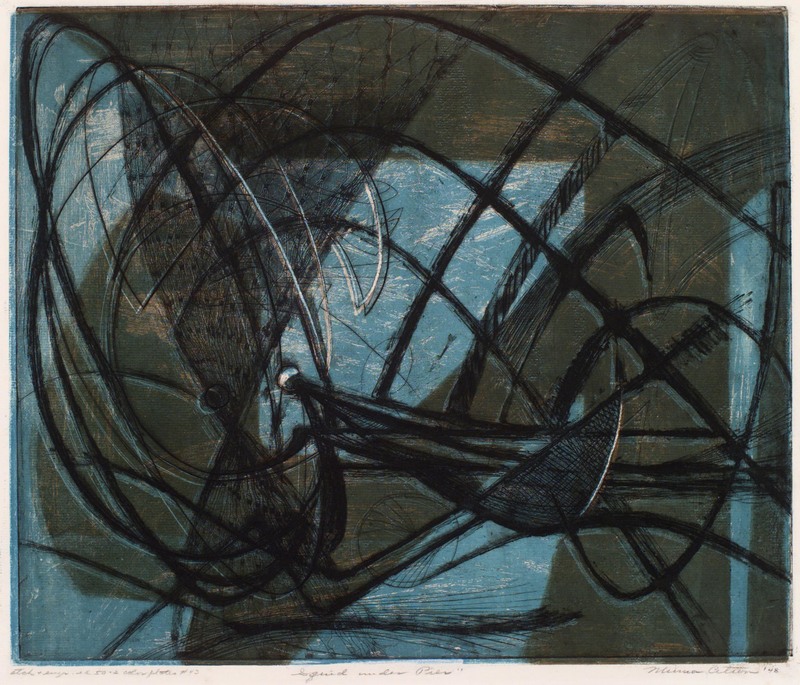Squid under Pier
Item
Title
Squid under Pier
Creator
Minna Wright Citron
American, 1896–1991
American, 1896–1991
Date
1948
Materials
Engraving, soft-ground etching, and gauffrage with stencil
Measurements
Plate: 15 x 17-3/4 in. (38 x 45.3 cm), sheet: 19-15/16 x 21-15/16 in. (50.5 x 55.7 cm)
Description
Two years after completing Men Seldom Make Passes, Citron more fully realized the potential for abstract expression in Squid under Pier. Influenced by Hayter’s predilection for Surrealist automatism, as well as his interest in water and its inhabitants—in particular those from the cephalopod family—the intaglio took shape only after a prolonged effort on the part of the artist to match her subconscious thoughts to the numerous more deliberated sketches she made at her desk. The resulting image was among Citron’s personal favorites, and certainly can be considered to be the most important print she produced at Atelier 17.
Citron herself offered perhaps the most cogent reading of Squid under Pier in the catalogue for a 1950 exhibition of her graphic work at the New School for Social Research:
"The component in “Squid under Pier,” which, sometime after the completion of the print, came to be called “squid,” is a threatening entanglement of tortuous, menacing lines: black lines, white lines, bitten lines and incised lines, with exciting variety in third dimensionality, forming a linear pattern of dynamic tensions and of great plastic depth. Contrasting with this disturbing agitation are the quiet interpenetrating, transparent planes of the neutral-colored “pier” and the fluid open areas of light-blue “sea” and “sky.” It is as though one might escape from these encircling tentacles to a temporary shelter and security under the “pier” and finally to peace and tranquility in the timeless and limitless space of fair skies and open sea. “Squid under Pier” satisfies because it achieves a harmonic pattern of relationships in its component parts and dynamic equilibrium as an integrated whole."
The text for this label has been adapted in part from an unpublished essay by former Penn State art history graduate student Barbara Kutis (MA 2007).
Citron herself offered perhaps the most cogent reading of Squid under Pier in the catalogue for a 1950 exhibition of her graphic work at the New School for Social Research:
"The component in “Squid under Pier,” which, sometime after the completion of the print, came to be called “squid,” is a threatening entanglement of tortuous, menacing lines: black lines, white lines, bitten lines and incised lines, with exciting variety in third dimensionality, forming a linear pattern of dynamic tensions and of great plastic depth. Contrasting with this disturbing agitation are the quiet interpenetrating, transparent planes of the neutral-colored “pier” and the fluid open areas of light-blue “sea” and “sky.” It is as though one might escape from these encircling tentacles to a temporary shelter and security under the “pier” and finally to peace and tranquility in the timeless and limitless space of fair skies and open sea. “Squid under Pier” satisfies because it achieves a harmonic pattern of relationships in its component parts and dynamic equilibrium as an integrated whole."
The text for this label has been adapted in part from an unpublished essay by former Penn State art history graduate student Barbara Kutis (MA 2007).
Source
Palmer Museum of Art, The Pennsylvania State University, Gift of Thomas Citron
Identifier
2002.101
Rights
This image is posted publicly for non-profit educational uses, excluding printed publication. Other uses are not permitted.

